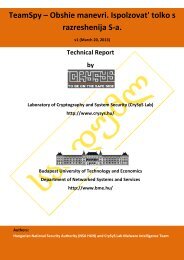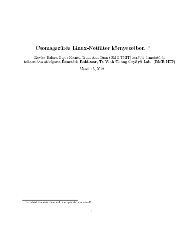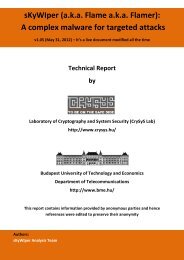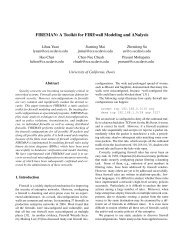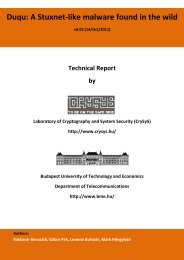Create successful ePaper yourself
Turn your PDF publications into a flip-book with our unique Google optimized e-Paper software.
Estimated normalised average anonimity set size (S 0 /N)<br />
1<br />
0.8<br />
0.6<br />
0.4<br />
0.2<br />
B = [72 5 5 5 3]<br />
B = [30 30 30]<br />
0<br />
0 20 40 60 80 100<br />
Number of compromised members (c)<br />
Estimated normalised average anonimity set size (S 0 /N)<br />
1<br />
0.8<br />
0.6<br />
0.4<br />
0.2<br />
2.5. The group-based approach<br />
B = [60 30 15]<br />
B = [60 5 5 3 3 2]<br />
0<br />
0 20 40 60 80 100<br />
Number of compromised members (c)<br />
Figure 2.5: The value of ¯ S0/N as a function of c for different branching factor vectors. The figure<br />
illustrates, how different systems can be compared based on the approximation ¯ S0/N. On the left<br />
hand side, we can see that the value of ¯ S0/N is greater for the vector (72, 5, 5, 5, 3) than for the<br />
vector (30, 30, 30) not only for c = 1 (as we saw earlier), but for larger values of c too. On the<br />
right hand side, we can see that ¯ S0/N is almost the same for the vector (60, 5, 5, 3, 3, 2) as for the<br />
vector (60, 30, 15). We can conclude that ¯ S0/N is essentially determined by the value of the first<br />
element of the branching factor vector.<br />
2.5 The group-based approach<br />
In the group based authentication scheme, the set of all tags is divided into groups of equal size,<br />
and all tags of a given group share a common group key. Since the group keys do not enable<br />
the reader to identify the tags uniquely, every tag also stores a unique identifier. Keys are secret<br />
(each group key is known only to the reader and the members of the corresponding group), but<br />
identifiers can be public. To avoid impersonation of a tag from the same group, every tag has a<br />
unique secret key as well. This key is only shared between the tag and the reader. To reduce the<br />
storage demands on the reader side, the pairwise key can be generated from a master key using<br />
the identifier of the tag.<br />
In order to authenticate a tag, the reader sends a single challenge to the tag. The answer of the<br />
tag has two parts. In the first part, the tag answers to the reader by encrypting with the group key<br />
the reader’s challenge concatenated with a nonce picked by the tag, and the tag’s identifier. In the<br />
second part, the tag encrypts the challenge concatenated with the nonce using its own secret key.<br />
Encrypting the identifier is needed since the key used for encryption does not identify uniquely the<br />
tag. Upon reception of the answer, the reader identifies the tag by trying all the group keys until<br />
the decryption succeeds. Then it checks the second part, that it was encrypted by the same tag.<br />
Without the second part, every tag could impersonate every other tag in the same group.<br />
The operation of the group-based private authentication scheme is illustrated in Figure 2.6.<br />
The complexity of the group-based scheme for the reader depends on the number of the groups.<br />
In particular, if there are γ groups, then, in the worst case, the reader must try γ keys. Therefore,<br />
if the upper bound on the worst case complexity is given as a design parameter, then γ is easily<br />
determined. For example, to get the same complexity as in the key-tree based scheme with constant<br />
branching factor, one may choose γ = (b log b N) − 1, where N is the total number of tags and b is<br />
the branching factor of the key-tree. The minus one indicates the decryption of the second part of<br />
the message.<br />
An immediate advantage of the group-based scheme with respect to the key-tree based approach<br />
is that the tags need to store only two keys and an identifier. In contrast to this, in the key-tree<br />
based scheme, the number of keys stored by the tags depends on the depth of the tree. For instance,<br />
in the case of the Molnar-Wagner scheme, the tags must store log b N keys. Moreover, by using<br />
only two keys, this scheme also has a smaller complexity for the tag in terms of computation and<br />
communication.<br />
Besides its advantages with respect to complexity, the group-based scheme provides a higher<br />
23



